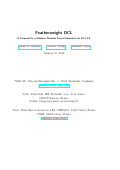Featherweight OCL: A Proposal for a Machine-Checked Formal Semantics for OCL 2.5
Achim D. Brucker, Frédéric Tuong und Burkhart Wolff
 The Unified Modeling Language (UML) is one of the few modeling languages that is widely used in industry. While UML is mostly known as diagrammatic modeling language (e.g., visualizing class models), it is complemented by a textual language, called Object Constraint Language (OCL). OCL is based on a three-valued logic that turns UML into a formal language. Unfortunately the semantics of this specification language, captured in the Annex A of the OCL standard, leads to different interpretations of corner cases. We formalize the core of OCL: denotational definitions, a logical calculus and operational rules that allow for the execution of OCL expressions by a mixture of term rewriting and code compilation. Our formalization reveals several inconsistencies and contradictions in the current version of the OCL standard. Overall, this document is intended to provide the basis for a machine-checked text Annex A of the OCL standard targeting at tool implementors.
The Unified Modeling Language (UML) is one of the few modeling languages that is widely used in industry. While UML is mostly known as diagrammatic modeling language (e.g., visualizing class models), it is complemented by a textual language, called Object Constraint Language (OCL). OCL is based on a three-valued logic that turns UML into a formal language. Unfortunately the semantics of this specification language, captured in the Annex A of the OCL standard, leads to different interpretations of corner cases. We formalize the core of OCL: denotational definitions, a logical calculus and operational rules that allow for the execution of OCL expressions by a mixture of term rewriting and code compilation. Our formalization reveals several inconsistencies and contradictions in the current version of the OCL standard. Overall, this document is intended to provide the basis for a machine-checked text Annex A of the OCL standard targeting at tool implementors.
Schlüsselwörter:
Kategorien: ,
Dokumente: (Artikel als PDF Datei) (Outline)
 Bitte zitieren sie diesen Artikel wie folgt:
Bitte zitieren sie diesen Artikel wie folgt:
Achim D. Brucker, Frédéric Tuong und Burkhart Wolff.
Featherweight OCL: A Proposal for a Machine-Checked Formal Semantics for OCL 2.5.
In Archive of Formal Proofs, 2014. http://www.isa-afp.org/entries/Featherweight_OCL.shtml, Formal proof development
(Artikel als PDF Datei) (Outline) (BibTeX) (Endnote) (RIS) (Word) (
 )
)
| abstract | = | {The Unified Modeling Language (UML) is one of the few modeling languages that is widely used in industry. While UML is mostly known as diagrammatic modeling language (e.g., visualizing class models), it is complemented by a textual language, called Object Constraint Language (OCL). OCL is based on a three-valued logic that turns UML into a formal language. Unfortunately the semantics of this specification language, captured in the Annex A of the OCL standard, leads to different interpretations of corner cases. We formalize the core of OCL: denotational definitions, a logical calculus and operational rules that allow for the execution of OCL expressions by a mixture of term rewriting and code compilation. Our formalization reveals several inconsistencies and contradictions in the current version of the OCL standard. Overall, this document is intended to provide the basis for a machine-checked text Annex A of the OCL standard targeting at tool implementors.}, | |
| author | = | {Achim D. Brucker and Fr{\'e}d{\'e}ric Tuong and Burkhart Wolff}, | |
| file | = | {https://www.brucker.ch/bibliography/download/2014/brucker.ea-featherweight-outline-2014.pdf}, | |
| filelabel | = | {Outline}, | |
| issn | = | {2150-914x}, | |
| journal | = | {Archive of Formal Proofs}, | |
| month | = | {jan}, | |
| note | = | {\url{http://www.isa-afp.org/entries/Featherweight_OCL.shtml}, Formal proof development}, | |
| = | {https://www.brucker.ch/bibliography/download/2014/brucker.ea-featherweight-2014.pdf}, | ||
| title | = | {{Featherweight} {OCL}: A Proposal for a Machine-Checked Formal Semantics for {OCL} 2.5}, | |
| url | = | {https://www.brucker.ch/bibliography/abstract/brucker.ea-featherweight-2014}, | |
| year | = | {2014}, |

